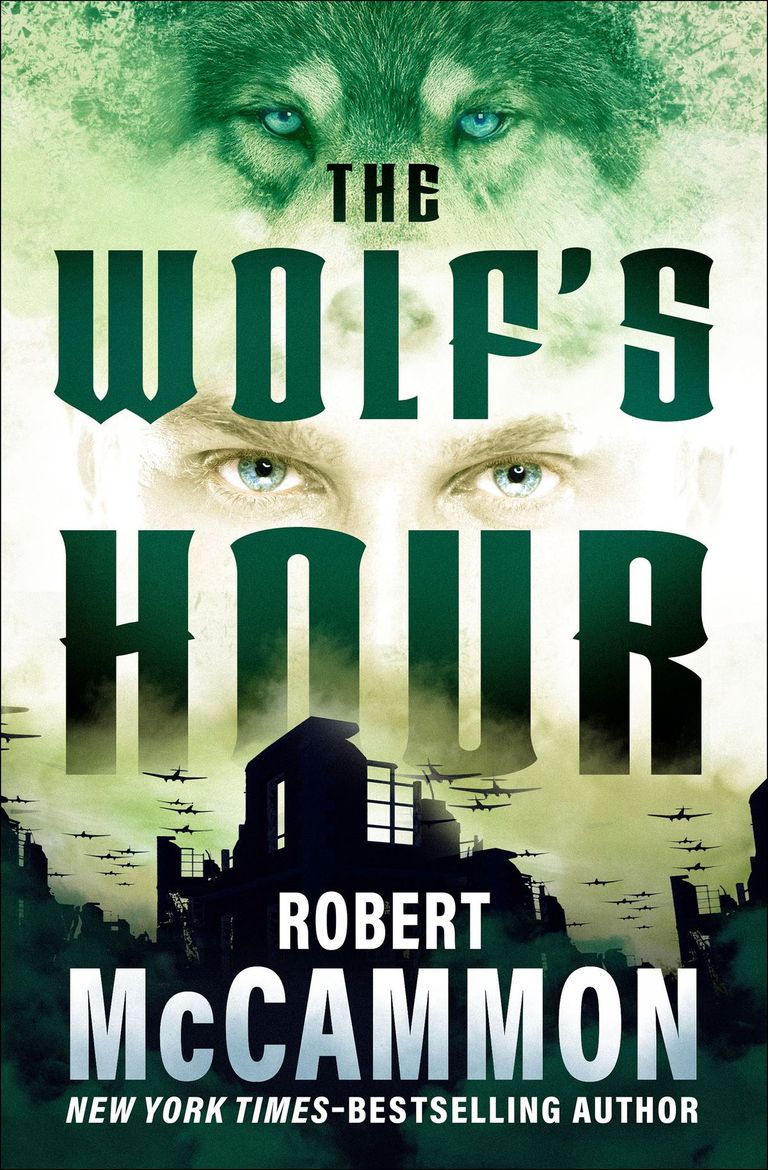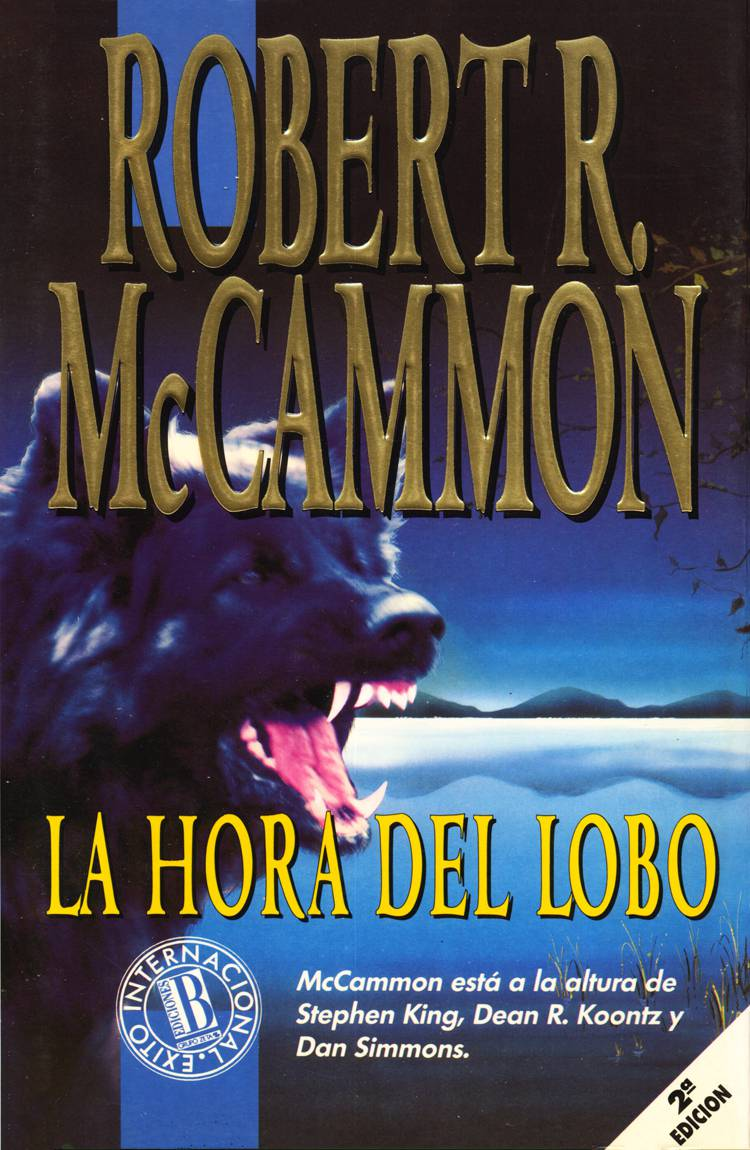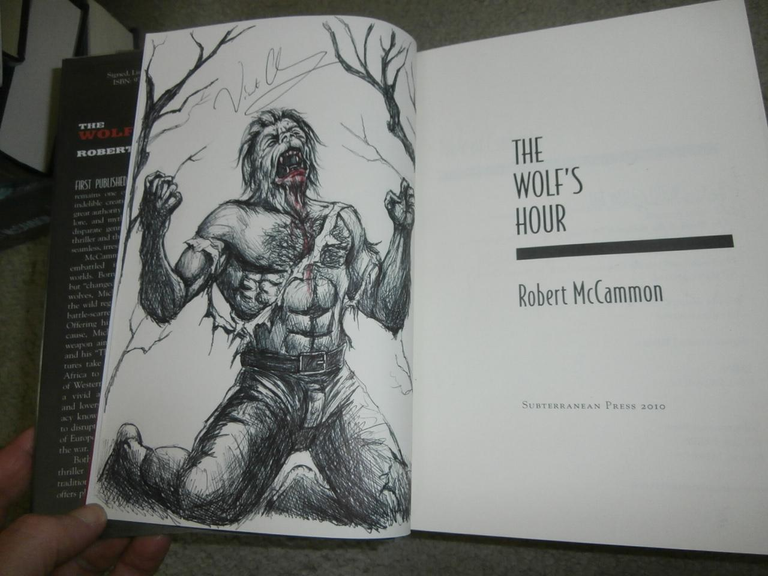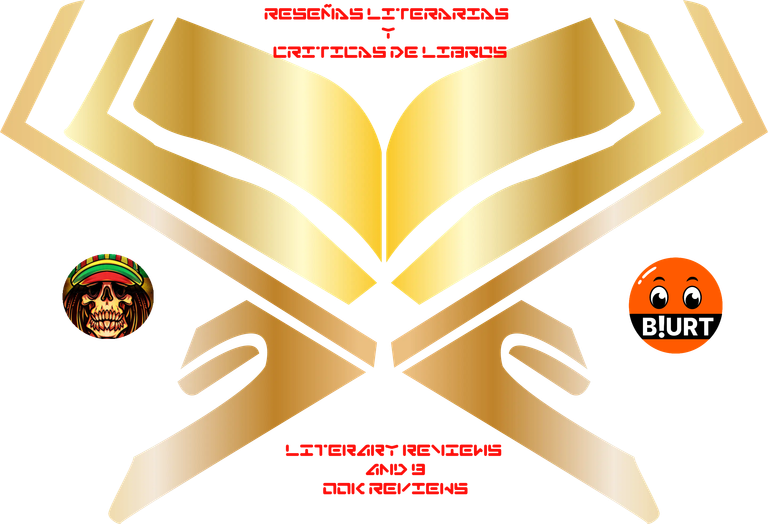
I continue to share with #BLURT friends who love good literature the works of Robert McCammon, one of the best authors of fantsay and horror.
Today I want to tell you about The Wolf's Hour, Nominated for the Bram Stoker Award 1989.
Like almost all his illustrious colleagues with a pen loaded with blood and guts, Robert McCammon always proves to be much more at ease with the short story form than with the long distance. The Wolf's Hour is no exception, but fortunately McCammon knows the rules of genre writing by heart and thanks to a cinematic style, studied to give strength to the images in the minds of readers, he gives us an easy and immediate novel without heavy subtexts or useless lucubrations.
The structure of the story is far too linear but McCammon remedies it by mixing a wide range of genres and tones, from war novels to spy stories, from erotic to horror, managing to avoid the traps of a mix that is too exotic or elaborate.
The archetype of the Werewolf is approached here with some variations and it is interesting even if ultimately these are not revolutionary reinterpretations capable of providing us with an unexpected reading of the werewolf. McCammon does not skimp on splatter/hard scenes that find their peak in the chapter dedicated to the Brimstone Club and that somehow refer to the erossvastika genre. There may not be poetry but at least they beat pretty hard and pour abundant gallons of bloody liquid.

Sigo compartiendo con los amigos de #BLURT amantes de la buena literatura las obras de Robert McCammon, uno de los mejores autores de fantasy y horror.
Hoy les quiero comentar sobre La Hora del Lobo, Nominada al Premio Bram Stoker 1989.
Como casi todos sus ilustres colegas con la pluma llena de sangre y entrañas, Robert McCammon siempre se muestra mucho más cómodo en la forma del relato breve que en la de larga distancia.** La Hora del Lobo** no es una excepción, pero afortunadamente McCammon se sabe de memoria las reglas de la escritura de género y gracias a un estilo cinematográfico, diseñado para dar fuerza a las imágenes en la mente de los lectores, nos ofrece una novela fácil e inmediata sin subtextos elucubraciones pesadas o inútiles.
La estructura de la historia es demasiado lineal pero McCammon lo compensa mezclando una amplia gama de géneros y tonos, desde la novela de guerra a la historia de espías, desde lo erótico al terror, logrando evitar las trampas de una mezcla que Es demasiado exótico o elaborado.
El arquetipo del hombre lobo se aborda aquí con algunas variaciones y esto es interesante aunque en última instancia no se trate de reinterpretaciones revolucionarias capaces de proporcionarnos una lectura inesperada del hombre lobo. McCammon no escatima en escenas splatter/hard que encuentran su punto máximo en el capítulo dedicado al Brimstone Club y que de alguna manera remiten al género erossvastika. No habrá poesía, pero al menos te golpearán bastante fuerte y se derramarán muchos litros de sangre.

From the hardback dust jacket of British publisher Grafton:
‘And then the clouds came after him, about to engulf him. He ran, but he couldn't run fast enough. Faster. Faster. The storm roared at his heels. Faster. His heart was pounding. A banshee scream in his ears. Faster...
And a change burst through him. Dark hair sprouted on his hands and arms. He felt his spine contort, arching his shoulders. His hands - they were no longer hands - touched the ground. He ran faster, his body jerked like a saw, and he began tearing off his clothes....
The year is 1944. A message from Paris warns Allied intelligence that something important is brewing, something that could have serious consequences for D-Day. The only way to get more information from the agent in Paris, now closely guarded by the Gestapo, is to send a personal courier.
Russian émigré Michael Gallatin is chosen for the job. Gallatin, who is retired as a secret agent after a harrowing episode in North Africa, is parachuted into occupied France on a mission that will take him into the festering heart of the Third Reich, following the trail of the end of the world.
As an expert spy, Gallatin has proved he can take on formidable enemies and kill them. As a passionate lover, he attracts beautiful women. But there is an additional factor that makes Michael Gallatin a unique special agent: he is a werewolf, capable of shapeshifting almost at will, able to assume the body of a wolf and his ability to kill with a savage, snarling fury.
In the madness of war, Gallatin hunts his prey, ready to overpower his opponents with his honed brain or tear their throats out with his razor-sharp teeth...
The Hour of the Wolf is a novel by Robert McCammon, master of horror fiction, that breaks the mould of the werewolf novel. It is a remarkable story of fast-paced excitement and a fascinating, complex and compelling portrayal of the werewolf as both a noble warrior and a being torn by conflict.
From Pocket Books:
He is Michael Gallatin, master spy, lover and werewolf. Able to shape-shift with lightning speed, to kill silently or with a savage, snarling fury, he proved his talents against Rommel in Africa. Now he faces his most delicate and dangerous mission yet: to unravel the secret Nazi plan known as the Iron Fist. From a parachute jump in occupied France to the lush corruption of Berlin, from the arms of a beautiful spy to the cold embrace of a madman's death machine, Gallatin draws ever closer to the shocking truth about the Iron Fist. But just hours before D-Day, he is caught in the Nazis' web of destruction....
Robert McCammon writes about Hour of the Wolf
About The Hour of the Wolf
by Robert McCammon
I started Hour of the Wolf with the idea that I wanted to do a werewolf story with a difference, combined with elements of romance and heroism. I wanted my werewolf to be a man who often enjoys being a creature that runs on all fours, with a keen sense of smell and sight. At times, Michael Gallatin would rather be a wolf than a human being.
He also wanted to do away with some of the conventions of werewolf stories. He saw no need for werewolves to be restricted to the full moon to change, nor did it necessarily have to be at night. He wanted to create creatures who had struggled to take control of their situation rather than being at the mercy of their circumstances. Which is not to say that the life of a werewolf is easy; as one of the characters says, ‘A werewolf never dies of old age’.
As much as possible, I wanted to try to make the development and life of these creatures as believable as possible. Which meant that they would learn to endure extreme hardship, because how else could they live except in the wild? But I think it would be a great joy to learn to see the world as a wolf does, to learn (and it wouldn't be easy) to run on all fours and use the tail as a rudder, to hunt prey and kill it with tooth and claw, and generally to survive on a level that was both brutal and elegant.
The fusion of brutality and elegance is what I was trying to achieve, and I hope it succeeded reasonably well. Hour of the Wolf is set during the Second World War, and moves back and forth in time to show how Michael Gallatin became a werewolf and also follows his current mission in occupied France as a British secret agent. I have been asked why I chose World War II as the time frame, and not the modern era. My answer is that the period of World War II seems to be, wrongly or rightly, a very romantic time in world history. Romantic, that is, in the sense that one knew who wore the black hats and who wore the white hats. It was a period of apocalyptic decisions and events, and most certainly the crucial period of the 20th century. It seemed appropriate for Hour of the Wolf, which is basically the story of nature versus technology.
I also grew up reading Ian Fleming's James Bond novels, and wanted to create a character who loved life but had no qualms about killing if the situation demanded it. Michael Gallatin is not a man who kills for pleasure, but he is certainly a dangerous man because he knows, like the wolf, that killing is essential to his survival. I also wanted Michael Gallatin to be a compassionate man, in the sense that his work and the nature of killing are not his only purpose. He is a professional at his craft, but he is certainly not a machine and I wanted him to have very human emotions.


De la sobrecubierta de tapa dura de la editorial británica Grafton:
"Y entonces las nubes vinieron tras él, a punto de engullirlo. Corrió, pero no pudo correr lo suficientemente rápido. Más rápido. Más rápido. La tormenta rugía tras sus talones. Más rápido. Su corazón latía con fuerza. Un grito de banshee en sus oídos. Más rápido...
Y un cambio estalló en él. El vello oscuro brotó de sus manos y brazos. Sintió que su columna se contorsionaba, arqueando sus hombros. Sus manos —ya no eran manos— tocaron el suelo. Corrió más rápido, su cuerpo se sacudió como una sierra, y comenzó a arrancarse la ropa...
Estamos en el año 1944. Un mensaje de París advierte a los servicios de inteligencia aliados de que se está gestando algo importante, algo que podría tener consecuencias graves para el Día D. La única forma de obtener más información del agente en París, ahora vigilado de cerca por la Gestapo, es enviar un mensajero personal.
El emigrado ruso Michael Gallatin es elegido para el puesto. Gallatin, que se encuentra retirado como agente secreto tras un espantoso episodio en el norte de África, es lanzado en paracaídas sobre la Francia ocupada en una misión que lo llevará al corazón purulento del Tercer Reich, siguiendo el rastro del fin del mundo.
Como espía experto, Gallatin ha demostrado que puede enfrentarse a formidables enemigos y matarlos. Como amante apasionado, atrae a mujeres hermosas. Pero hay un factor adicional que convierte a Michael Gallatin en un agente especial único: es un hombre lobo, capaz de cambiar de forma casi a voluntad, capaz de asumir el cuerpo de un lobo y su capacidad de matar con una furia salvaje y gruñona.
En la locura de la guerra, Gallatin caza a su presa, dispuesto a superar a sus oponentes con su cerebro afinado o a desgarrarles la garganta con sus dientes afilados...
La hora del lobo es una novela de Robert McCammon, maestro de la ficción de terror, que rompe con el molde de la novela de hombres lobo. Es una historia notable de emoción trepidante y una representación fascinante, compleja y convincente del hombre lobo como un guerrero noble y un ser desgarrado por el conflicto.
Del libro de bolsillo Pocket Books:
Él es Michael Gallatin, maestro espía, amante y hombre lobo. Capaz de cambiar de forma a la velocidad del rayo, de matar en silencio o con una furia salvaje y gruñona, demostró su talento contra Rommel en África. Ahora se enfrenta a su misión más delicada y peligrosa: desentrañar el plan nazi secreto conocido como Puño de Hierro. Desde un salto en paracaídas en la Francia ocupada hasta la exuberante corrupción de Berlín, desde los brazos de una hermosa espía hasta el frío abrazo de la máquina de muerte de un loco, Gallatin se acerca cada vez más a la espantosa verdad sobre el Puño de Hierro. Pero a solo unas horas del Día D, está atrapado en la red de destrucción de los nazis...
Robert McCammon escribe sobre La hora del lobo
Acerca de La hora del lobo
de Robert McCammon
Comencé La hora del lobo con la idea de que quería hacer una historia de hombres lobo diferente, combinada con elementos de romance y heroísmo. Quería que mi hombre lobo fuera un hombre que a menudo disfruta de ser una criatura que corre a cuatro patas, con un agudo sentido del olfato y la vista. A veces, Michael Gallatin preferiría ser un lobo que un ser humano.
También quería acabar con algunas de las convenciones de los cuentos de hombres lobo. No veía ninguna necesidad de que los hombres lobo estuvieran restringidos a la luna llena para cambiar, ni tampoco tenía que ser necesariamente de noche. Quería crear criaturas que hubieran luchado por tomar el control de su situación en lugar de estar a merced de sus circunstancias. Lo cual no quiere decir que la vida de un hombre lobo sea fácil; como dice uno de los personajes, "Un hombre lobo nunca muere de viejo".
En la medida de lo posible, quise intentar que el desarrollo y la vida de estas criaturas fueran lo más creíbles posible. Lo que significaba que aprenderían a soportar dificultades extremas, porque ¿de qué otra manera podrían vivir si no fuera en un entorno salvaje? Pero creo que sería una gran alegría aprender a ver el mundo como lo hace un lobo, aprender (y no sería fácil) a correr a cuatro patas y usar la cola como timón, a cazar presas y matarlas con los dientes y las garras y, en general, a sobrevivir en un nivel que fuera al mismo tiempo brutal y elegante.
La fusión de brutalidad y elegancia es lo que estaba tratando de lograr, y espero que haya tenido un éxito razonablemente bueno. La hora del lobo está ambientada durante la Segunda Guerra Mundial, y avanza y retrocede en el tiempo para mostrar cómo Michael Gallatin se convirtió en un hombre lobo y también sigue su misión actual en la Francia ocupada como agente secreto británico. Me han preguntado por qué elegí la Segunda Guerra Mundial como marco temporal, y no la era moderna. Mi respuesta es que el período de la Segunda Guerra Mundial parece ser, equivocada o acertadamente, un momento muy romántico en la historia del mundo. Romántico, es decir, en el sentido de que uno sabía quién usaba los sombreros negros y quién usaba los sombreros blancos. Fue un período de decisiones y eventos apocalípticos, y más seguramente el período crucial del siglo XX. Parecía adecuado para La hora del lobo , que es básicamente la historia de la naturaleza versus la tecnología.
También crecí leyendo las novelas de James Bond de Ian Fleming , y quería crear un personaje que amara la vida pero que no tuviera reparos en matar si la situación lo exigía. Michael Gallatin no es un hombre que mata por placer, pero sin duda es un hombre peligroso porque sabe, como el lobo, que matar es fundamental para su supervivencia. También quería que Michael Gallatin fuera un hombre compasivo, en el sentido de que su trabajo y la naturaleza de matar no son su único objetivo. Es un profesional en su oficio, pero sin duda no es una máquina y quería que tuviera emociones muy humanas.

Hour of the Wolf is a departure for me in the sense that it is not necessarily a horror novel, although its basis is the werewolf story. It is not horror, at least, in the supernatural sense, but the horror in Hour of the Wolf is created by human hands, with a ‘horror genre’ figure as the hero. I wanted to turn popular culture's idea of the werewolf as a dumb brute who, in the light of the full moon, is compelled to tear apart and destroy. In Hour of the Wolf, it is the world beyond the werewolves that is brutal and destructive, while the werewolves themselves kill not for pleasure, but for survival.
I enjoyed researching the behaviour of the wolves before starting the book, and I also enjoyed reading a lot of military history and facts about the personalities of the time, some of whom appear in the book. It was fun to write Hour of the Wolf and I ho

La hora del lobo es un cambio para mí en el sentido de que no es necesariamente una novela de terror, aunque su base es la historia del hombre lobo. No es terror, al menos, en el sentido sobrenatural, pero el horror en La hora del lobo está creado por manos humanas, con una figura del "género de terror" como héroe. Quería darle la vuelta a la idea de la cultura popular de que el hombre lobo es un bruto tonto que a la luz de la luna llena se ve obligado a destrozar y destruir. En La hora del lobo , es el mundo más allá de los hombres lobo el que es brutal y destructivo, mientras que los propios hombres lobo matan no por placer, sino para sobrevivir.
Disfruté investigando el comportamiento de los lobos antes de empezar el libro, y también disfruté leyendo mucha historia militar y datos sobre las personalidades de la época, algunas de las cuales aparecen en el libro. Fue divertido escribir La hora del lobo y espero continuar la historia de Michael Gallatin en el futuro.

Source images / Fuente imágenes: Robert McCammon.


Fuente de la imagen banner final post / Image source banner final post.

Congratulations, your post has been upvoted by @dsc-r2cornell, which is the curating account for @R2cornell's Discord Community.
Enhorabuena, su "post" ha sido "up-voted" por @dsc-r2cornell, que es la "cuenta curating" de la Comunidad de la Discordia de @R2cornell.
Thank you for curating my content @dsc-r2cornell.